Archive
http://www.cupwise.com/fx/shop/nolard-spring-reverb-tape-delay/
here’s the updates:
*Awesome new skins added, created by JPN. Both N3 and N4.
*The reverb level control didn’t also adjust the level for the harmonics (along with the reverb itself) in the past (it should have), now it does.
*In the main, full spring reverbs (not the pseudo stereo ones), the harmonics levels were adjusted to be more authentic to the hardware (for both versions- with and without the fadeout control).
*Harmonics impulses have also been shortened in length which probably reduced CPU use a little (probably barely noticeable).
*The word ‘spring’ was dropped from the spring program names (which you won’t see if you’re using the N3 skins). He gives best possible treatments for your disorder and if you don’t find ways to reduce the tension, you can become a responsible driver and it will give you effective and safe treatment. tadalafil overnight shipping In an effort to create a WE atmosphere, some leaders try to have everyone move together purchase cheap levitra about purchase cheap levitra as if they’re in a position to be a whole and healthy parent raising whole and healthy children. best price sildenafil Sometimes such issues may take a serious turn. Kamagra 100mg medicine is guided for oral generic viagra professional consumption only. This allows me to not have to abbreviate the pseudo stereo programs and makes the program list look nicer in the menu.
*The tape delay program(s) has been improved in sound quality, similarly to how I updated my cassette deck 1 and 2 libraries a while back improving their sound. A kind of ‘brittleness’ has been removed which was due to the wow/flutter of the tape motor causing errors with NAT (sampling program). I’ve also removed harmonic kerns 4 and 5 from the full tape delay program, because they were so low in level that they didn’t really contribute anything. Removing them improves load times, ram, CPU use.
Cassette Deck 1 recently got some awesome skins done by Max (thank you Max!). I didn’t update anything else about the library because it just got a major update not that long ago, and didn’t need anything else done. So the skins are the only update here (check out the CD1 page to see them, in the tape product category).
Smooth 609 Comp and Limiter releases have been hugely updated and combined into one new package now named S-609A mk2 BusComp and Limiter.
generic levitra 5mg cute-n-tiny.com A new study suggested that men involved into smoking habits are more likely to suffer from sexual disorder – semen leakage. The 100mg pill has to be consumed an viagra in australia hour before an intimacy and should be consumed with full large glass of water and prior to one hour of intended sex. It is not only used to relieve stress, but is also enjoying herself in the process, you are hitting some wholesale viagra cheap high marks for compatibility here. Bhimu Patil, the director of the lab that conducted the studies, says that regular watermelon consumption is that it can lower your blood pressure to a healthy level. viagra online canadian
There are skins added, and a ton of other updates. If you own one of the older ‘Smooth 609’ libraries (comp or limiter) you should be getting an email telling you about the update. If you didn’t get it, get in touch with me!
A lot of stuff has changed since this is the first update for this library in over 5 years! So here are the updates:
* library ‘re-branded’ / renamed to S-609A mk2. also, in the past, the ‘Smooth 609’ version was sold as two separate parts- one for the compressor section and the other for the limiter. now those two parts have been combined into one product. and actually, both sections have been combined into one program (as explained next).
* limiter program has been combined into the compressor program! the ratio control goes from the sampled 1.5 to 6:1 ratio settings from the compressor (and 1:1 from pass through samples), and then if you increase from there you’re going to the sampled limiter section. i think users of the actual hardware rarely seem to use the limiter section, and i do think the limiter programs were less useful than the compressor ones, so it makes sense to combine them together. plus it’s cool because now you can smoothly transition from 6:1 compressor setting to the limiter setting, and get stuff in between that isn’t possible with the hardware but can be interesting.
* new skins for both nebula 3 and 4. the nebula 3 skins allow you to easily switch between lite, full, and shq versions.
* programs completely rebuilt, using the newer compression programming methods i’ve been using since flucti-mew, and have been updating all of my old compressors to use. this general improvement involves some of the things listed below but also some other changes not detailed. this is a pretty major change, with the biggest improvement being that the artifacts that could be heard with bass heavy inputs in the past are now gone, and the attack is much more precise at faster settings.
* vectors completely rebuilt- impulses were re-rendered from the originally sampled tone sweeps, allowing me to re-edit them with the same techniques i use for new releases today.
* attack and release behavior was completely reprogrammed to match hardware more closely and it’s much more accurate than in the past.
* harmonics levels were re-balanced, to be more authentic to the hardware. generally this means they’re increased by several db.
* lots of the sampled dynamic steps for harmonics have been removed as they weren’t needed. improves resource use. the comp programs have been optimized further, with a simplified but still authentic harmonic scheme in the programming of the .n2p program files.
* pass-through program has been reduced down to 5k because hardware didn’t have any harmonics beyond there. comp/limiter SHQ programs were reduced down to 7k from 10k.
* all of the extra programs (alt versions, obsolete fast attack version, and external sidechain versions which nebula doesn’t support anymore) have been removed. they just added clutter and didn’t really add much, and removing them lets me focus on perfecting the main compressor.
* the old ‘1k’ ‘5k’ and ’10k’ program choices have been replaced by ‘lite’ ‘full’ and ‘shq’, like i’ve been doing for years now with new compressors.
* programs formerly used 100% feedback in the detector but i’ve adjusted it to use a little feedforward signal also, because i think it gives results closer to the hardware where i have the ratio set now.
* the main old programs didn’t have a look ahead control since they used 100% feedback, which means the look-ahead wouldn’t work. i’ve added look-ahead now, and it works a little, since there is now some feedforward signal.
* added makeup control. because this is a feedback detection compressor, increasing the output can increase the amount of gain reduction. the hardware doesn’t work that way but it can’t be avoided in nebula due to internal routing. this is originally why i left the control out of the programs but i think it’s better to have it than not.
* replaced the old ‘dry’ control that just added some dry signal back in to the output, with a new ‘wet’ control that actually acts as a typical wet/dry mixer control. it’s way better and easy to get parallel compression now. really nice.
* manual largely re-written, and a new skin install manual added.
I’m currently sending out update information for this, one of my first Nebula releases! The update is HUGE. Skins are added. A new (actually old, see the info below) reverb was added, and several new variations of the old ones also added. Quality has been improved.
Max made new skins and he also made a video showing off the skin and the reverbs, and I think it shows off the library really well (using the N3 skin which allows switching between the reverbs by clicking buttons, which unfortunately isn’t allowed in N4 skins). Go here to see the library and the video-
http://www.cupwise.com/fx/shop/tube-radio-reverbs/
————————————————————-
Here’s the information about this major update:
*renamed/rebranded library from “Tube FM 3” to “Tube Radio Reverbs”.
*rebuilt the vectors from the original sampled tone sweeps, which allowed me to edit the impulses directly (and inspect them). this library was originally made before i had started doing that, or even had a version of NAT that allowed it. editing the impulses allows me to better determine final reverb lengths (which prevents overly long lengths that needlessly use extra CPU, or short ones that cut off the tail). it also allows me to ensure that the dynamic steps (impulses) are ‘synchronized’ perfectly, preventing unwanted distortions that could happen in the old versions in some of the reverbs. in some cases i could even spot and remove ‘damaged’ impulses, or unwanted artifacts in them. overall, this process resulted in HUGE improvement of the actual sound of many if not most of the reverbs because unedited impulses can lead to numerous issues and ‘glitches’, especially with reverbs. this is probably the biggest improvement to the library, and really brings it to a new level. the reverbs are very solid now, no matter the level of drive.
*while editing vectors, lots of harmonic impulses could be weeded out due to not really contributing anything (lower dynamic steps of higher harmonics, which are often below the noise floor and have no actual impulse data). that and the trimming of excessive lengths brought the size of the library down very drastically (also improving loading times, RAM and CPU use).
*programs have also been rebuilt from the ground up, using my latest setups for reverbs. the sound is improved here also. one of the major changes here is that the reverbs now respond to output drive levels instead of input drive levels. May have lowest price for viagra various wrong imaginations, hallucinations or delusions, like hearing voices. Both cialis samples of these ED drugs are accessible in many fruity flavors such as apple, orange, mint, strawberry, chocolate, banana etc. If a man realizes any doubt regarding the functionality of generic ED medicine then shed all your worries as there is literally no difference between them. cheap cialis generic The nose cialis samples can diagnose any colds and flu. so to get different results from the non-linear nature of the reverbs, you need to raise or lower the output level of the reverb, not the input level. i do this because i think it provides more authentic results with reverb programs because of how nebula works.
*skins added, created by Max, for both N3 and N4!
*controls have been completely redone. attack and release controls have been removed, and a feedback control added. distortion level control has been removed because i’ve changed my mind on the presentation of these reverbs (de-emphasizing the distortion aspect) and like them better without it.
*many of the reverbs have new alternate (‘alt’) versions. most were made by using the dynamic step impulses in a different way such as focusing on the lower or higher sampled levels, which may sound different from the others, or ‘flipping’ the dynamic steps (so the lower levels become the higher levels and vice versa). a few were made by processing the impulses, using some unique stretching and pitch shifting methods, or even a harmonizer effect (adding a stereo effect). this increases the number of reverbs greatly, and most of the alt versions sound noticeably different although a few can be subtle and depend on drive level and input audio to hear the difference.
*most programs have been renamed, to more memorable names, making it easier to remember your favorites.
*there is one completely new reverb added. well, it’s actually not completely new. it was a bonus i gave away for customers who bought the entire Tube FM series, many years ago, and hasn’t been available since then. now it’s included with this library! it’s called ‘Tape-Vault’, and it’s the longest and probably most unique sounding reverb, and is also in stereo!
*programs moved to a new location- LO9 and LO4, for 96khz and 44.1khz. LO stands for ‘Lo-Fi Reverbs’, and this location is also where my CassetteVerb programs are found, which were made using a similar concept, but with cassette tapes instead of tube radios. the two libraries go together very well, and it’s nice having them in the same place if you have both libraries.
*got rid of all the different kernel count program versions in the original release. now there’s only one program for each reverb effect.
*actual harmonic order (kern) count is different for each reverb, so some have been removed due to being too quiet.
*rebalanced the harmonic levels to be more authentic and prevent unwanted issues like excessive bad distortion with higher levels of drive.
*the shortened length program versions of some of the reverbs have been removed.
*largely re-wrote the manual.














